Hello! This page will explore 8 trees that I observed and identified along the Olentangy River Trail in the University District of Columbus, OH. Last year, I took the School of Environmental and Natural Resources’ Woody Plant Identification course. I learned a lot about tree identification that has come in handy, but still have much to improve upon. I enjoyed revisiting my tree ID skills during this assignment and am excited to progress them further.
Tree 1: Eastern Cottonwood (Populus deltoides)
This juvenile Eastern Cottonwood was found along the riverbank of the Olentangy Trail, right underneath Lane Ave. I would describe this as a mesic forest. Cottonwoods are easily distinguishable by their large, uniquely shaped leaves. Furthermore, the bark of young cottonwoods has recognizable shallow furrows. Cottonwoods are known for being valuable to artisans, as their bark is very suitable for carvings (https://gardenerdy.com/factors-to-remember-for-cottonwood-tree-identification/).
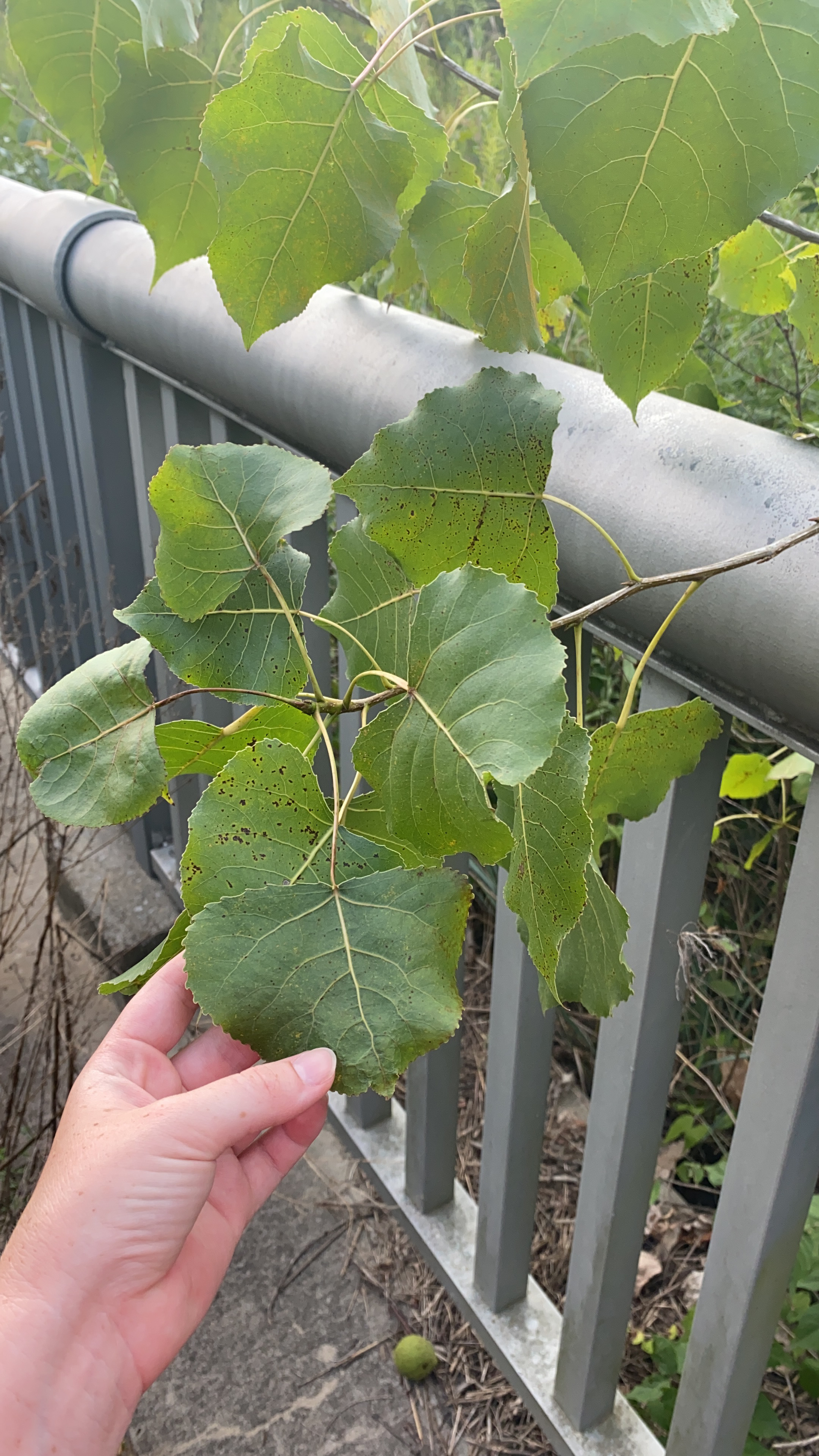
Triangular shaped leaves with serrations along the edges. Leaves are alternate, simple and have a flat stalk.
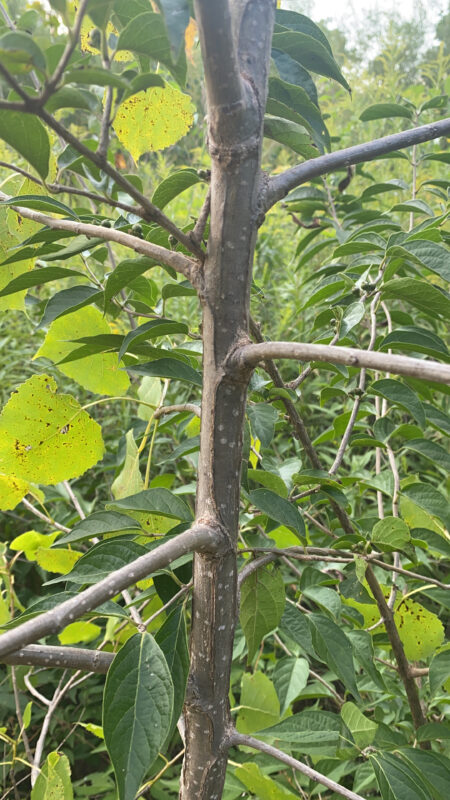
Young trees typically have silvery-grey bark with smooth, shallow furrows. This can be seen here.
Tree 2: Black Locust (Robinia pseudoacacia)
I found this specimen at the same sight, along the Olentangy River trail. As is typical for this species, it was growing in a sunnier patch of the riverbank. Black locusts are shade-intolerant. This species can be distinguished from the honey locust by its lack of three-pronged spines. Another common name for this species is false acacia, which is the translation of the scientific name. Pseudo translates to fake or false (https://en.wikipedia.org/wiki/Robinia_pseudoacacia).
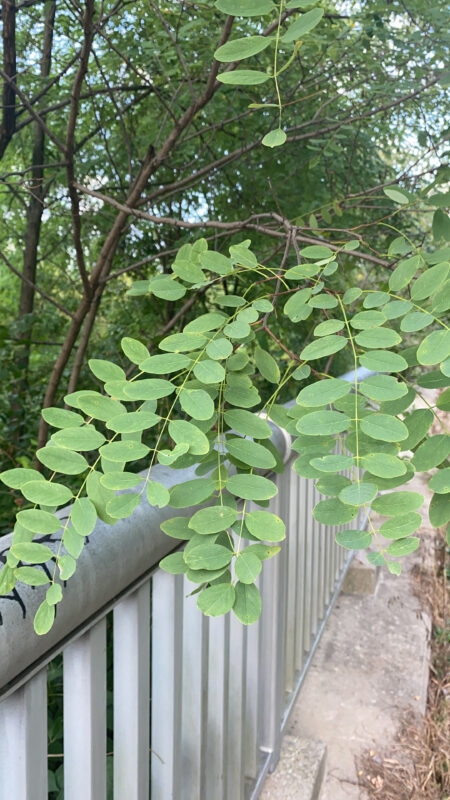
Compound leaves with one leaflet at the tip.
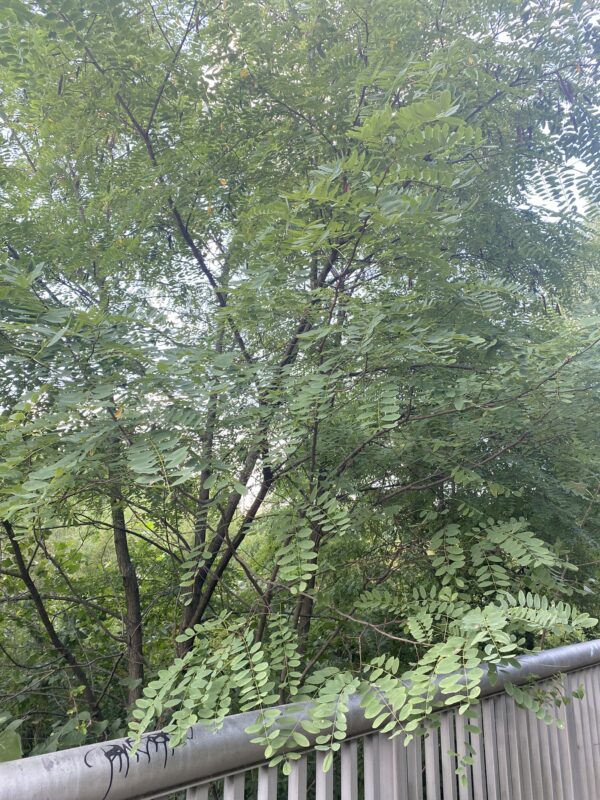
Bark is a reddish black color and was painted by a reddish color in the grooves. Tree is growing considerably upright.
Tree 3: Common Pear (Pyrus communis)
This common pear specimen was also found along the Olentangy River trail. I first noticed the distinct color and texture of these leaves. They have a dark green, glossy appearance from above, as is characteristic of many pear species. Twigs are a reddish brown with a glossy texture. The leaves and bark of this species can be used to heal wounds because it acts as an anti-inflammatory (https://citeseerx.ist.psu.edu/viewdoc/download?doi=10.1.1.962.1802&rep=rep1&type=pdf#:~:text=in%20urinary%20therapeutics%2C%20as%20skin,because%20of%20low%20sucrose%20content).
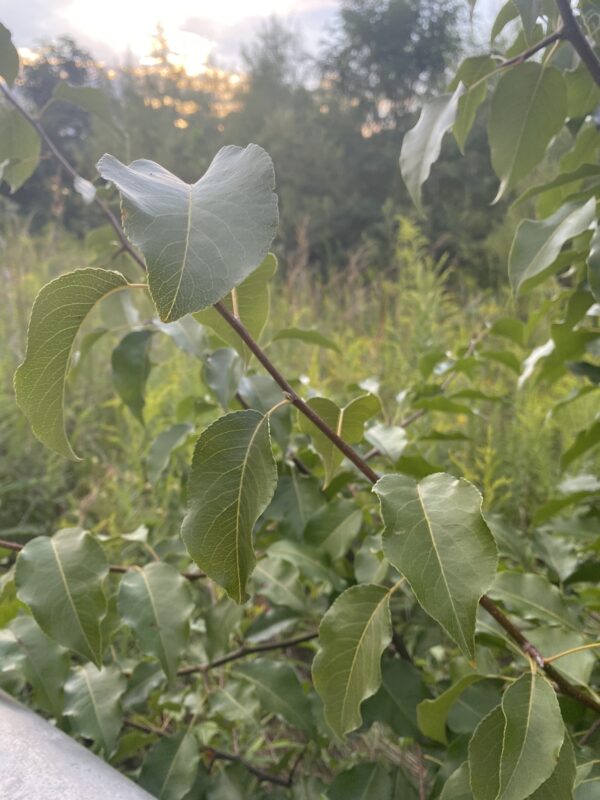
Smooth, glossy dark green and somewhat heart-shaped. Leaves are smooth underneath and have a glossy texture on top. They are alternate and simple with fine, toothed serrations along the edges.
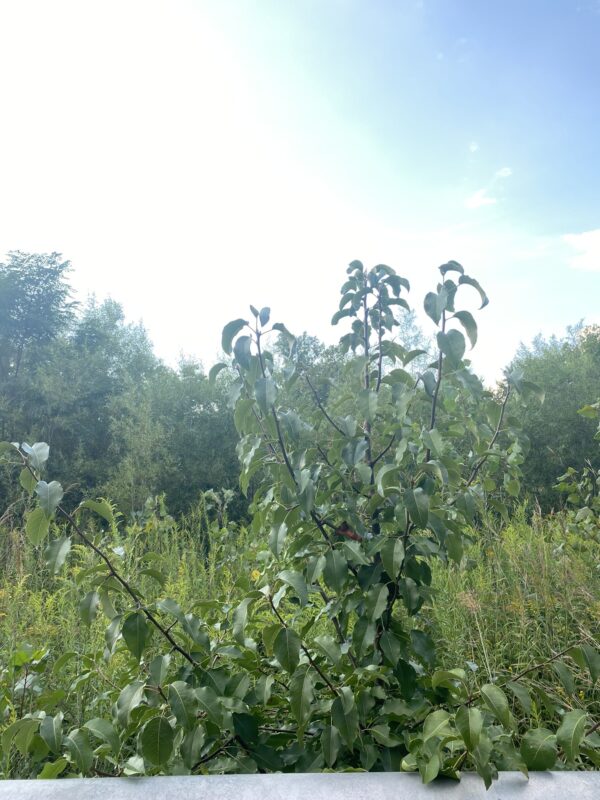
Juvenile specimen represents the typical narrow branch angles of the common pear tree shape.
Tree 4: American sycamore (Platanus occidentalis)
We covered this tree in my Woody Plants course last fall, so I remembered the distinct leaves immediately upon seeing them! To me, they appear to have a similar shape to maples leaves, just much larger. Furthermore, I expected to find many specimens of this species along the Olentangy River trail, because their preferred habitat is forested riverbanks. The most distinguishing feature, however, is the way that sycamore bark peels and reveals a white, smooth layer near the base of mature trees. Though this was a juvenile specimen, I could see the unique texture beginning to show on trunk. Aphids can heavily infest sycamores as they suck the sap from them. Though harmless to the tree, this can deposit honeydew on whatever is below (https://www.treehugger.com/identify-common-american-sycamore-tree-1343174#:~:text=Description%20and%20Identification,-Meinrad%20Riedo%20%2F%20Getty&text=The%20complexion%20of%20its%20trunk,May%20and%20are%20not%20showy.)

Juvenile American sycamore bark shows the small white bumps and furrows that are characteristic of this species.
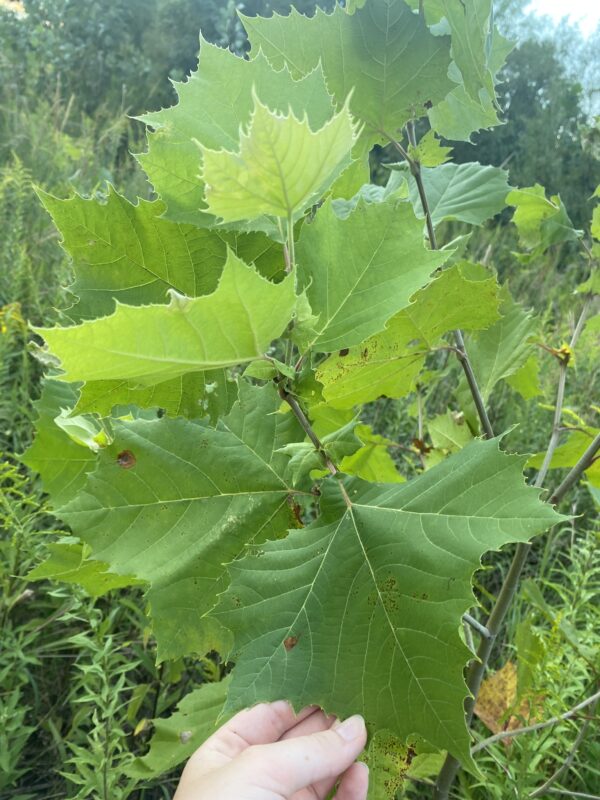
Simple, alternate leaves with palmate veins. Typically 4 to 8 inches wide with widely toothed margins and 3 to 5 lobes.
Tree 5: European Hornbeam (Carpinus betulus)
I located this tree along the trail, however it was opposite the riverbank unlike the previous four. Leaves are distinguishable by their finely toothed edges and pointed tips. Hornbeam tonic was said to be an excellent cure for tiredness and exhaustion (https://www.woodlandtrust.org.uk/trees-woods-and-wildlife/british-trees/a-z-of-british-trees/hornbeam/).
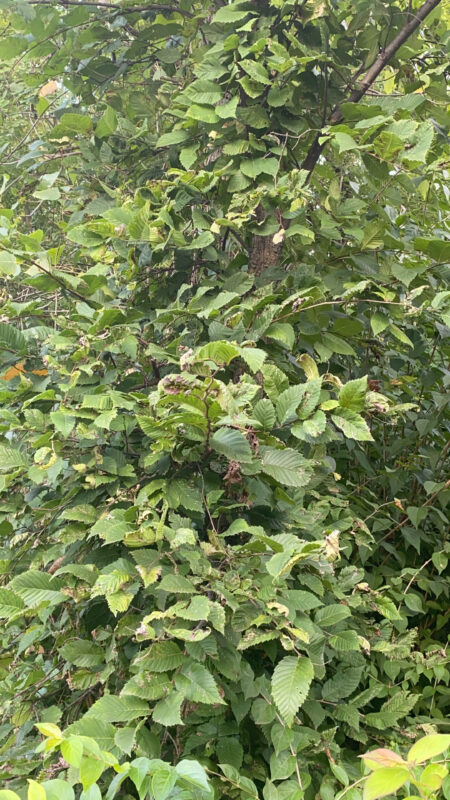
Leaves are oval with pointed tips and finely toothed edges.

Specimen represented a tall, bulbous form typical of European hornbeam.
Tree 6: Common Hackberry (Celtis occidentalis)
I also found this specimen along the Olentangy River trail, opposite of the riverbank. This species is another that I remember well from Woody Plants. The most prominent feature of the Common Hackberry is it’s unique bark texture. My instructor described it as looking like dripping candlewax, which has helped me identify it ever since. The common name is derived from “hagberry,” which means “marsh berry. This is the term for cherries in Scotland (https://www.wildflower.org/plants/result.php?id_plant=CEOC).
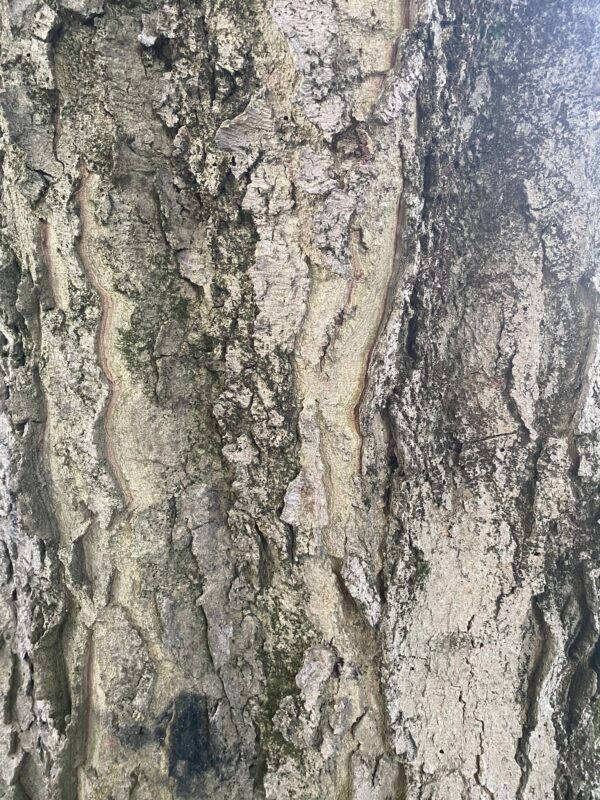
“Dripping candlewax” bark along the trunk.
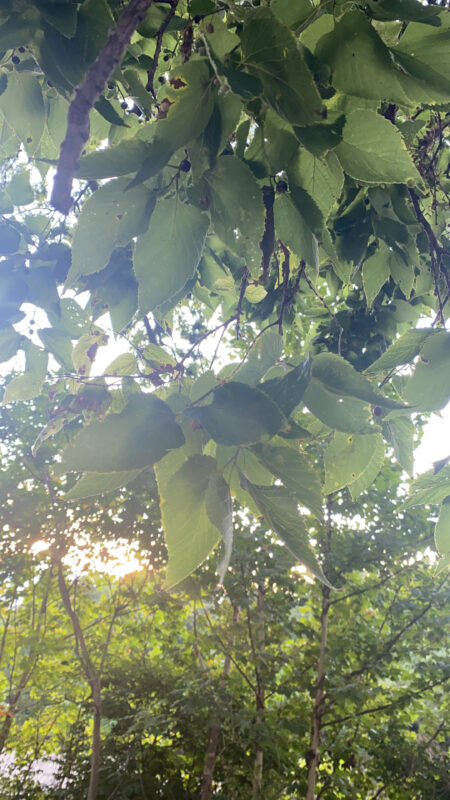
Small dark purple berries are pictured near the top of the image. Furthermore, the leaves have a sickly looking tint to them by being splotched with yellow patches. This is characteristic of hackberries.
Tree 7: Freeman’s Maple (Acer x freemanii)
Though I am familiar with maples, I didn’t know how common hybrids of this genus were until I encountered one on the trail! After doing some research, I learned that the Freeman’s Maple is a cross between Silver Maple (Acer saccharinum) and Red Maple (Acer rubrum) (https://www.minnesotawildflowers.info/tree/freeman-maple. ) Apparently, this hybrid is very common across this region. Furthermore, I learned that hybrid trees are usually sterile, which means they produce few to no fruits and flowers. Though I knew this happened with other classes of species, I had never considered that hybrid trees would be sterile, too. Woah!
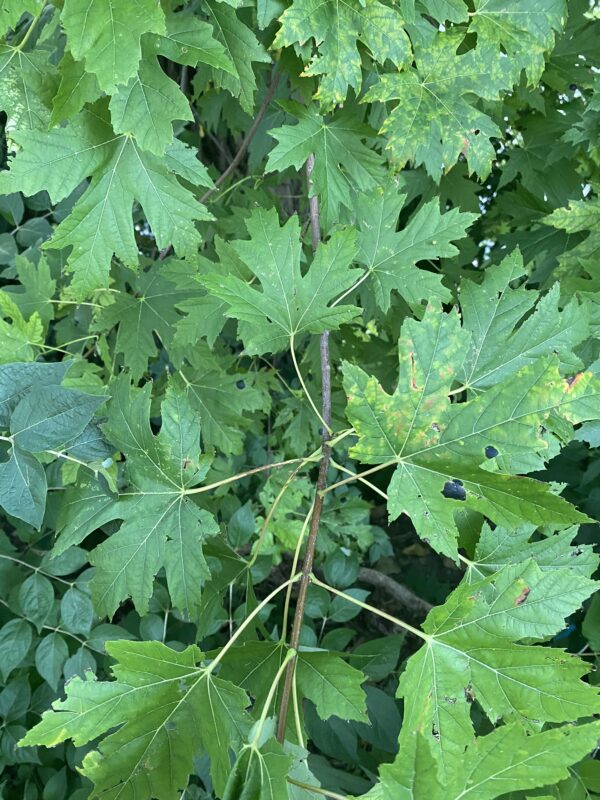
Leaves are simple, opposite, and stalked. They are most similar to red maple leaves. However, the central lobe narrows at the base here, whereas red maples have a square shaped central lobe.

Tree shape varies and is largely understudied in this species, however you can see the form of this specimen here.
Tree 8: White Mulberry (Morus alba)
This tree was located along the trail, but further back from the riverbank than any other specimen. The leaves were a smooth, dull green and distinguishable by hair along the veins underneath the surface. According to health resources, the fruit from this tree is an excellent source of antioxidants. It’s said to be a great alternative medicine for laxative and antiseptic issues (https://www.verywellhealth.com/the-benefits-of-white-mulberry-88659).

Young bark is brown-orange in color.
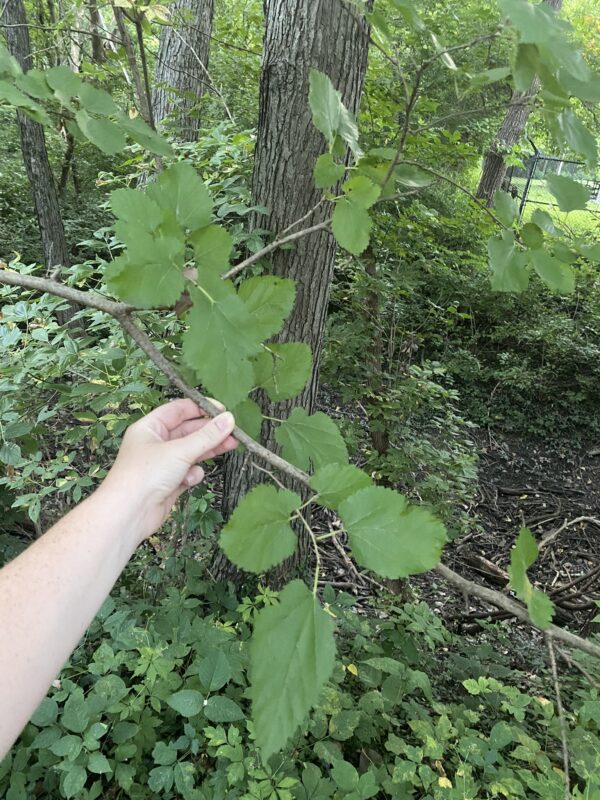
Simple, alternate leaves that are rounded at the base.
